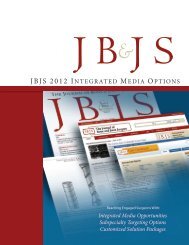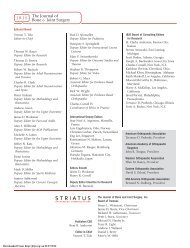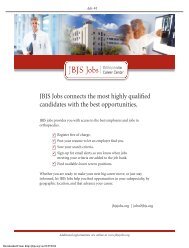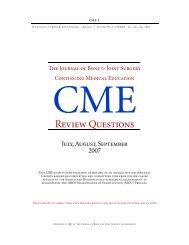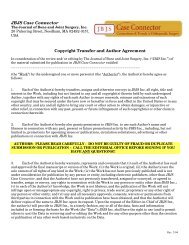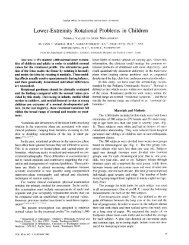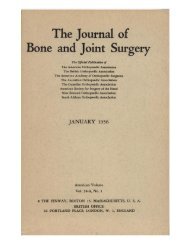Front Matter - The Journal of Bone & Joint Surgery
Front Matter - The Journal of Bone & Joint Surgery
Front Matter - The Journal of Bone & Joint Surgery
You also want an ePaper? Increase the reach of your titles
YUMPU automatically turns print PDFs into web optimized ePapers that Google loves.
UNIQUE NATIONAL<br />
HCPCS CODE<br />
Q4084<br />
BRIEF SUMMARYFOR THE PHYSICIAN (CONSULT PACKAGE INSERT FOR FULL PRODUCT INFORMATION)<br />
CAUTION: Federal law restricts this device to sale by or on the order <strong>of</strong> a physician (or properly<br />
licensed practitioner).<br />
INDICATIONS Synvisc is indicated for the treatment <strong>of</strong> pain in osteoarthritis (OA) <strong>of</strong> the knee in patients<br />
who have failed to respond adequately to conservative nonpharmacologic therapy and simple analgesics,<br />
e.g., acetaminophen.<br />
CONTRAINDICATIONS • Do not administer to patients with known hypersensitivity (allergy) to hyaluronan<br />
(sodium hyaluronate) preparations. • Do not inject Synvisc in the knees <strong>of</strong> patients having knee joint<br />
infections or skin diseases or infections in the area <strong>of</strong> the injection site.<br />
WARNINGS • Do not concomitantly use disinfectants containing quaternary ammonium salts for skin<br />
preparation because hyaluronan can precipitate in their presence. • Do not inject Synvisc extra-articularly<br />
or into the synovial tissues and capsule. Local and systemic adverse events, generally in the area <strong>of</strong> the<br />
injection, have occurred following extra-articular injection <strong>of</strong> Synvisc. • Intravascular injections <strong>of</strong> Synvisc<br />
may cause systemic adverse events.<br />
PRECAUTIONS General • <strong>The</strong> effectiveness <strong>of</strong> a single treatment cycle <strong>of</strong> less than three injections <strong>of</strong><br />
Synvisc has not been established. • <strong>The</strong> safety and effectiveness <strong>of</strong> Synvisc in locations other than the<br />
knee and for conditions other than osteoarthritis have not been established. • Do not inject anesthetics or<br />
other medications into the knee joint during Synvisc therapy. Such medications may dilute Synvisc and<br />
affect its safety and effectiveness. • Use caution when injecting Synvisc into patients who are allergic to<br />
avian proteins, feathers, and egg products. • <strong>The</strong> safety and effectiveness <strong>of</strong> Synvisc in severely inflamed<br />
knee joints have not been established. • Strict aseptic administration technique must be followed.<br />
• STERILE CONTENTS. <strong>The</strong> syringe is intended for single use. <strong>The</strong> contents <strong>of</strong> the syringe must be used<br />
immediately after its packaging is opened. Discard any unused Synvisc. • Do not use Synvisc if package<br />
is opened or damaged. Store in original packaging (protected from light) at room temperature below<br />
86°F (30°C). DO NOT FREEZE. • Remove synovial fluid or effusion before each Synvisc injection.<br />
• Synvisc should be used with caution when there is evidence <strong>of</strong> lymphatic or venous stasis in that leg.<br />
Information for Patients • Provide patients with a copy <strong>of</strong> the Patient Labeling prior to use. • Transient<br />
pain, swelling and/or effusion <strong>of</strong> the injected joint may occur after intra-articular injection <strong>of</strong> Synvisc.<br />
In some cases the effusion may be considerable and can cause pronounced pain; cases where swelling<br />
is extensive should be discussed with the physician. • As with any invasive joint procedure, it is<br />
recommended that the patient avoid any strenuous activities or prolonged weight-bearing activities<br />
such as jogging or tennis following the intra-articular injection.<br />
Use in Specific Populations •Pregnancy: <strong>The</strong> safety and effectiveness <strong>of</strong> Synvisc have not been<br />
established in pregnant women. •Nursing mothers: It is not known if Synvisc is excreted in human milk.<br />
<strong>The</strong> safety and effectiveness <strong>of</strong> Synvisc have not been established in lactating women. • <strong>The</strong> safety and<br />
effectiveness <strong>of</strong> Synvisc have not been established in children.<br />
ADVERSE EVENTS<br />
Adverse Events Involving the Injected <strong>Joint</strong><br />
Clinical Trials: A total <strong>of</strong> 511 patients (559 knees) received 1771 injections in seven clinical trials <strong>of</strong><br />
Synvisc. <strong>The</strong>re were 39 reports in 37 patients (2.2% <strong>of</strong> injections, 7.2% <strong>of</strong> patients) <strong>of</strong> knee pain and/or<br />
swelling after these injections. Ten patients (10 knees) were treated with arthrocentesis and removal <strong>of</strong><br />
joint effusion. Two additional patients (two knees) received treatment with intra-articular steroids. Two<br />
patients (two knees) received NSAIDs. One <strong>of</strong> these patients also received arthrocentesis. One patient was<br />
treated with arthroscopy. <strong>The</strong> remaining patients with adverse events localized to the knee received no<br />
treatment or only analgesics.<br />
Postmarket Experience: <strong>The</strong> most common adverse events reported have been pain, swelling and/or<br />
effusion in the injected knee. In some cases the effusion was considerable and caused pronounced pain.<br />
In some instances, patients have presented with knees that were tender, warm and red. It is important to<br />
rule out infection or crystalline arthropathies in such cases. Synovial fluid aspirates <strong>of</strong> varying volumes<br />
have revealed a range <strong>of</strong> cell counts, from very few to over 50,000 cells/mm 3 . Reported treatments<br />
included symptomatic therapy (e.g., rest, ice, heat, elevation, simple analgesics and NSAIDs) and/or<br />
arthrocentesis. Intra-articular corticosteroids have been used when infection was excluded. Rarely,<br />
arthroscopy has been performed. <strong>The</strong> occurrence <strong>of</strong> post-injection effusion may be associated with<br />
patient history <strong>of</strong> effusion, advanced stage <strong>of</strong> disease and/or the number <strong>of</strong> injections a patient receives.<br />
Reactions generally abate within a few days. Clinical benefit from the treatment may still occur after<br />
such reactions.<br />
<strong>The</strong> clinical trials described above included 38 patients who received a second course <strong>of</strong> Synvisc<br />
injections (132 injections). <strong>The</strong>re were twelve reports in nine patients (9.1% <strong>of</strong> injections, 23.7% <strong>of</strong><br />
patients) <strong>of</strong> knee pain and/or swelling after these injections. Reports <strong>of</strong> two additional clinical trials in<br />
which patients received repeated courses <strong>of</strong> Synvisc treatment have appeared during the post-marketing<br />
period. One <strong>of</strong> these trials included 48 patients who received 210 injections during a second course <strong>of</strong><br />
Synvisc treatment 1 ; the other contained 71 patients who received 211 injections during a second course<br />
<strong>of</strong> Synvisc treatment. A total <strong>of</strong> 157 patients have received 553 injections in the three clinical trials <strong>of</strong><br />
repeated courses <strong>of</strong> Synvisc treatment. <strong>The</strong> reports in these trials describe a total <strong>of</strong> 48 reports <strong>of</strong> adverse<br />
events localized to the injected knee in 35 patients that occurred after injections that patients had received<br />
during their second course <strong>of</strong> treatment. <strong>The</strong>se adverse events accounted for 6.3% <strong>of</strong> injections in 22.3%<br />
A division <strong>of</strong> Genzyme Corporation<br />
55 Cambridge Parkway<br />
Cambridge, MA 02142<br />
1-888-3SYNVISC<br />
www.synvisc.com<br />
<strong>of</strong> patients as compared to 2.2% <strong>of</strong> injections in 7.2% <strong>of</strong> patients in a single course <strong>of</strong> Synvisc injections.<br />
In addition, reports <strong>of</strong> two retrospective studies during the post-marketing period have described adverse<br />
events localized to the injected knee that have occurred after 4.4% and 8.5% <strong>of</strong> injections that patients had<br />
received during one or more repeated courses <strong>of</strong> Synvisc treatment. 2,3 Intra-articular infections did not<br />
occur in any <strong>of</strong> the clinical trials and have been reported only rarely during clinical use <strong>of</strong> Synvisc.<br />
OTHER ADVERSE EVENTS<br />
Clinical Trials: In three concurrently controlled clinical trials with a total <strong>of</strong> 112 patients who received<br />
Synvisc and 110 patients who received either saline or arthrocentesis, there were no statistically<br />
significant differences in the numbers or types <strong>of</strong> adverse events between the group <strong>of</strong> patients that<br />
received Synvisc and the group that received control treatments.<br />
Systemic adverse events each occurred in 10 (2.0%) <strong>of</strong> the Synvisc-treated patients. <strong>The</strong>re was one case<br />
each <strong>of</strong> rash (thorax and back) and itching <strong>of</strong> the skin following Synvisc injections in these studies. <strong>The</strong>se<br />
symptoms did not recur when these patients received additional Synvisc injections. <strong>The</strong> remaining<br />
generalized adverse events reported were calf cramps, hemorrhoid problems, ankle edema, muscle pain,<br />
tonsillitis with nausea, tachyarrhythmia, phlebitis with varicosities and low back sprain.<br />
Postmarket Experience: Other adverse events reported include: rash, hives, itching, fever, nausea,<br />
headache, dizziness, chills, muscle cramps, paresthesia, peripheral edema, malaise, respiratory difficulties,<br />
flushing and facial swelling. <strong>The</strong>re have been rare reports <strong>of</strong> thrombocytopenia coincident with Synvisc<br />
injection. <strong>The</strong>se medical events occurred under circumstances where causal relationship to Synvisc is<br />
uncertain. (Adverse events reported only in worldwide postmarketing experience, not seen in clinical trials,<br />
are considered more rare and are italicized.)<br />
DETAILED DEVICE DESCRIPTION<br />
Each syringe <strong>of</strong> Synvisc contains:<br />
Hylan polymers (hylan A + hylan B) ..........................................16 mg<br />
Sodium chloride ........................................................................17 mg<br />
Disodium hydrogen phosphate ................................................0.32 mg<br />
Sodium dihydrogen phosphate monohydrate ..........................0.08 mg<br />
Water for injection ....................................................................q.s. to 2.0 mL<br />
HOW SUPPLIED<br />
Synvisc is supplied in a 2.25 mL glass syringe containing 2 mL Synvisc.<br />
Product Number: 58468-0090-1 3 disposable syringes<br />
<strong>The</strong> contents <strong>of</strong> the syringe are sterile and nonpyrogenic.<br />
DIRECTIONS FOR USE<br />
Synvisc is administered by intra-articular injection once a week (one week apart) for a<br />
total <strong>of</strong> three injections.<br />
Precaution: Do not use Synvisc if the package has been opened or damaged. Store in original packaging<br />
(protected from light) at room temperature below 86°F (30°C). DO NOT FREEZE.<br />
Precaution: Strict aseptic administration technique must be followed.<br />
Precaution: Do not concomitantly use disinfectants containing quaternary ammonium salts for skin<br />
preparation because hyaluronan can precipitate in their presence.<br />
Precaution: Remove synovial fluid or effusion before each Synvisc injection.<br />
Do not use the same syringe for removing synovial fluid and for injecting Synvisc, but the same needle<br />
should be used.<br />
Take particular care to remove the tip cap <strong>of</strong> the syringe and needle aseptically.<br />
Twist the gray tip cap before pulling it <strong>of</strong>f, as this will minimize product leakage.<br />
Inject Synvisc into the knee joint through an 18 to 22 gauge needle.<br />
To ensure a tight seal and prevent leakage during administration, secure the needle tightly while firmly<br />
holding the luer hub.<br />
Precaution: Do not over tighten or apply excessive leverage when attaching the needle or removing the<br />
needle guard, as this may break the tip <strong>of</strong> the syringe.<br />
Do not inject anesthetics or any other medications intra-articularly into the knee while administering<br />
Synvisc therapy. This may dilute Synvisc and affect its safety and effectiveness.<br />
Precaution: <strong>The</strong> syringe containing Synvisc is intended for single use. <strong>The</strong> contents <strong>of</strong> the syringe must<br />
be used immediately after the syringe has been removed from its packaging. Inject the full 2 mL in<br />
one knee only. If treatment is bilateral, a separate syringe must be used for each knee. Discard any<br />
unused Synvisc.<br />
This brief summary is based upon the current circular, 70230602, revised November 15, 2004.<br />
References: 1. Raynauld JP, Bellamy N, Goldsmith CH, Tugwell P, Torrance GW, Pericak D, et al. (2002).<br />
An evaluation <strong>of</strong> the safety and effectiveness <strong>of</strong> repeat courses <strong>of</strong> hylan G-F 20 for treating patients with<br />
knee osteoarthritis. Osteoarthritis Research Society International, 2002 OARSI World Congress on<br />
Osteoarthritis, Sydney, Australia [Paper reference #PS128]. Presentation on File. 2. Leopold SS, Warme WJ,<br />
Pettis PD and Shott S. (2002). Increased frequency <strong>of</strong> acute local reaction to intra-articular Hylan G-F 20<br />
(Synvisc) in patients receiving more than one course <strong>of</strong> treatment. J <strong>Bone</strong> <strong>Joint</strong> Surg. 2002;84-A(9):<br />
1619-1623. 3. Waddell DD, Estey DJ and Bricker D. (2001). Retrospective tolerance <strong>of</strong> Hylan G-F 20<br />
using fluoroscopically-confirmed injection and effectiveness <strong>of</strong> retreatment in knee osteoarthritis.<br />
Proceedings <strong>of</strong> the American College <strong>of</strong> Rheumatology Annual Meeting 2001. Presentation on File.<br />
SYNVISC and GENZYME are registered trademarks <strong>of</strong> Genzyme Corporation.<br />
©2007 Genzyme Corporation. All rights reserved. Printed inUSA. S-00269.A 01/2007<br />
Downloaded From: http://jbjs.org/ on 01/27/2014



